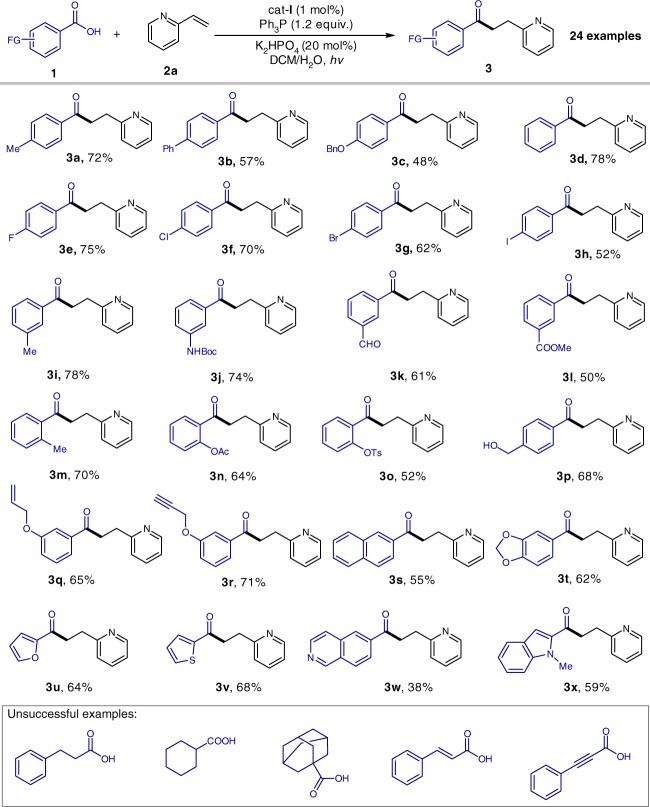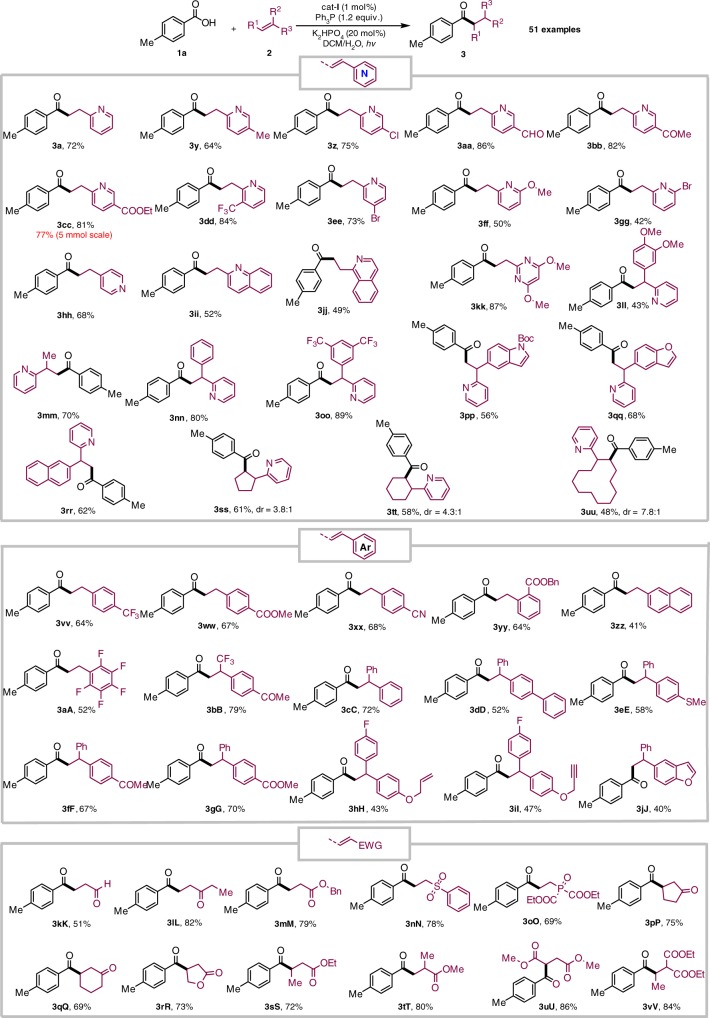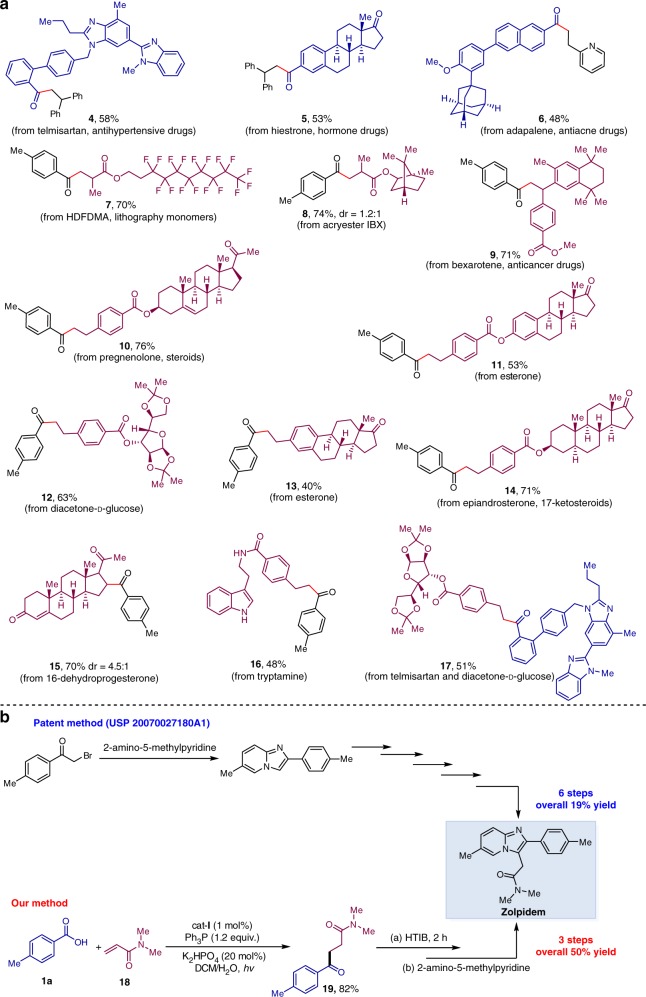Abstract
The construction of an aryl ketone structural unit by means of catalytic carbon–carbon coupling reactions represents the state-of-the-art in organic chemistry. Herein we achieved the direct deoxygenative ketone synthesis in aqueous solution from readily available aromatic carboxylic acids and alkenes, affording structurally diverse ketones in moderate to good yields. Visible-light photoredox catalysis enables the direct deoxygenation of acids as acyl sources with triphenylphosphine and represents a distinct perspective on activation. The synthetic robustness is supported by the late-stage modification of several pharmaceutical compounds and complex molecules. This ketone synthetic strategy is further applied to the synthesis of the drug zolpidem in three steps with 50% total yield and a concise construction of cyclophane-braced 18–20 membered macrocycloketones. It represents not only the advancement for the streamlined synthesis of aromatic ketones from feedstock chemicals, but also a photoredox radical activation mode beyond the redox potential of carboxylic acids.
Synthesis of aryl ketones can be generally achieved via C–C coupling strategies. Here, the authors show a deoxygenative coupling of carboxylic acids and alkenes enabled by photoredox catalysis and report a wide scope of products, including bioactive and macrocyclic ketones.
Introduction
Aromatic carboxylic acids are extremely promising feedstock chemicals, which can be used to rapidly populate libraries of complex small molecules1,2. To date, transition metal-catalyzed decarboxylative coupling enables aromatic carboxylic acids as an alternative source of aryl substructures3,4. Examination of thermodynamic data indicates that direct deoxygenative functionalization of aromatic carboxylic acid by activation of C–O bonds remains a serious challenge owing to the similar bond dissociation energies of C–C and C–O bonds (103 vs 102 kcal mol−1; Fig. 1a)5,6.
Fig. 1.
Applications of aromatic carboxylic acids in organic synthesis. a The nature choice of aromatic carboxylic acid. b Known ketone synthesis from acids (indirect strategies). c This work: direct deoxygenative C–C coupling by visible light
The concise forging of aryl ketone structural unit by means of carbon–carbon coupling represents the state of the art in synthetic chemistry as they are versatile building blocks for the construction of complex natural products and pharmaceuticals7. In order to streamline the synthesis of aryl ketones from aromatic carboxylic acids, certain activating steps are usually necessary to generate acid chlorides8–12, esters13–15, and amides16–20 for subsequent catalyzed or stoichiometric C–C bond formation with nucleophiles, such as organoborons and Grignard reagents (Fig. 1b). Especially, the recent efforts enabled the C–C coupling with mixed anhydride intermediates successful, which can be generated in situ from carboxylic acid and anhydrides21–23. However, the requirement of cautious operations and the preformation of intermediates compromises the functional group tolerance and synthetic flexibility together with the increasing demand of late-stage modification of complex target molecules in proteins or living cells under mild conditions. Therefore, the exploration of a practical and sustainable strategy for direct deoxygenative synthesis of ketones in aqueous solution from carboxylic acids is still very desirable but highly challenging.
Although an indirect deoxygenation coupling of acids with a few simple styrenes has been reported via the preformation of reactive anhydride intermediates, a large excess of moisture-sensitive dimethyldicarbonates and (TMS)3SiH reagents were required to initiate the photoredox catalytic cycle23. To overcome the mechanistically intrinsic drawbacks, we realized that the diversification of deoxygenation means would potentially offer a conceptually distinct activation mode of carboxylic acids for reaction development. An insight into the classical Wittig reaction24 inspires us to enquire if the strong P–O affinity between a Ph3P radical cation and a carboxylate anion could facilitate homolytic C–O bond cleavage of carboxylic acids. If feasible, such deoxygenative functionalization of aromatic acids would be independent of the oxidation potential of acids, and thus would significantly expand the synthetic applications. From our continuing efforts in photocatalysis25–28, we report herein a visible-light-mediated direct deoxygenation activation mechanism of carboxylic acids with cheap triphenylphosphine, which powers deoxygenative C–C coupling of aromatic carboxylic acids with a wide range of alkenes in aqueous solution in the absence of external anhydrides and hydrosilanes additives (Fig. 1c). It affords a general route to aromatic ketones from two easily accessible coupling partners without the involvement of air-sensitive reagents and harsh reaction conditions. This protocol allows practical and friendly reaction conditions which significantly broadens the substrate scope and emphasizes the synthetic application in complex molecules.
Results
Reaction optimization
Initially, the direct deoxygenative C–C coupling of 4-methylbenzoic acid (1a) and 2-vinylpyridine (2a) was chosen as the model reaction that could be used to optimize the reaction conditions (Table 1 and also Supplementary Table 1). The optimized reaction conditions include 1 mol% of [Ir(dF(CF3)ppy)2(dtbbpy)]PF6 (I) as a photocatalyst, 20 mol% K2HPO4 as a base, and 1.2 equiv. Ph3P as an O-transfer reagent in dichloromethane (DCM)/H2O (4:1, v/v) (Table 1, entry 1). Under the standard conditions, the corresponding ketone (3a) was obtained in 72% yield. When DCM was employed in place of DCM/H2O, the yield declined significantly, from 72 to 40% (Table 1, entry 2). It was interesting to find that the O-transfer reagent triphenylphosphine was essential for a successful deoxygenative transformation (Table 1, entry 3). Other photocatalysts such as fac-Ir(ppy)3 (II), Ru(bpy)3(PF6)2 (III), eosin Y (IV), and Acr+–Mes (V) were proved ineffective for this transformation (Table 1, entries 4–7). Control experiments also demonstrated that the reaction could not occur in the absence of either the photocatalyst or light (Table 1, entries 8 and 9).
Table 1.
Optimization of reaction conditions

| ||
|---|---|---|
| Entry | Variation of conditions | Yielda |
| 1 | None | 72% |
| 2 | Without H2O | 40% |
| 3 | No Ph3P | nd |
| 4 | 1 mol% cat-II instead of cat-I | nd |
| 5 | 2 mol% cat-III instead of cat-I | nd |
| 6 | 2 mol% cat-IV instead of cat-I | nd |
| 7 | 2 mol% cat-V instead of cat-I | nd |
| 8 | No photocatalyst | nd |
| 9 | No light | nd |
Standard conditions: photocatalyst I (1 mol%), 1a (0.2 mmol), 2a (1.5 equiv.), Ph3P (1.2 equiv.), K2HPO4 (20 mol%), DCM/H2O (2.0 mL, v/v = 4:1), rt, 5 W blue light-emitting diodes (LEDs), 48 h
nd not detected
aIsolated yield
Substrate scope of aromatic acids
With the optimized reaction conditions (Table 1, entry 1) in hand, we investigated the scope of the carboxylic acid substrates (Fig. 2). It was found that acyl radicals generated directly from carboxylic acids could site-selectively add to the β-position of the pyridyl ring with no detectable branched α-position selectivity. In general, aromatic carboxylic acids bearing both electron-donating (e.g., –Me, –Ph, and –BnO) and electron-withdrawing groups (e.g., –F and –Cl) at the para-position could react smoothly to produce linear ketones in good yields (3a–h). It is noteworthy that 4-bromo (3g) and 4-iodo (3h) benzoic acids tolerate the conditions well, and this provides an extremely important choice for downstream C–C coupling via palladium catalysis. The substituents on para-, meta-, and ortho-positions of aromatic rings had little influence on the reaction efficiency (3a–r). Significantly, carboxylic acids bearing versatile functional groups, such as –NHBoc, –CHO, –COOMe, –OAc, –OH, alkynyl, alkenyl, and acetal are competent reaction partners (3j–l, 3n–t). Terminal alkene and alkyne structural motifs are compatible with this radical transformation (3q and 3r). Heteroaromatic acids, including furan-, thiophene-, quinoline-, and indole-based acids uniformly underwent deoxygenative C–C coupling, furnishing the desired ketones (3u–x) in moderate yields. Besides aromatic acids, other kinds of carboxylic acids, including aliphatic carboxylic acids and α,β-unsaturated carboxylic acids however failed in this reaction.
Fig. 2.
Aromatic carboxylic acid scope. Bn benzyl; Boc tert-butoxycarbonyl; Ts para-toluenesulfonyl
Substrate scope of alkenes
Subsequently, many alkenes were examined, giving the results shown in Fig. 3. In view of the prevalence of the pyridine moiety in natural products, pharmaceuticals, and chiral ligands29,30, a wide range of structurally diverse 2-vinylpyridines possessing different kinds of functional groups were subjected to this protocol. Both electron-rich and electron-poor substituents, including –Me, –Cl, –CHO, –COOEt, –CF3, –Br, and –OMe at different positions of the pyridyl ring were well tolerated (3a, 3y–3gg). The benign compatibility of halogen substituents further emphasized the potential synthetic applications (3z, 3ee, and 3gg). 4-Vinylpyridines could be converted into the corresponding linear pyridine-based ketones (3hh) in 68% yields. Other heteroaromatic styrenes were also efficient substrates (3ii–kk). When a variety of 1,1-disubstituted vinylpyridines were employed, the desired products (3ll–rr) were obtained in 43–89% yields. Notably, the electron-rich indole and benzofuran could survive this radical process, indicative of good chemoselectivity (3pp and 3qq). Beside terminal alkenes, α,β-disubstituted alkenylpyridines successfully delivered the products (3ss–uu) in practically useful yields and with moderate diastereoselectivity. A gram-scale experiment demonstrated that this protocol could be easily scaled up (3cc, 5 mmol scale).
Fig. 3.
Alkene scope
To highlight the structural diversification of ketones, other kinds of styrenes were investigated and it was found that they could uniformly react with an aromatic carboxylic acid (1a) to give the desired ketone products (3vv–jJ) in moderate to good yields under the optimized conditions. Its synthetic potential is distinguished by excellent and important functional group compatibility as ketone, thioether, terminal olefin/alkyne, and ester are tolerated. Due to the ubiquity of 1,1-diarylalkane scaffolds in pharmaceuticals and natural products31, representative 1,1-diaryl olefins were used and they were found to deliver 3,3-diaryl-propanones (3ll–rr and 3cC–jJ) in 43–89% yields.
The γ-carbonyl ester and γ-diketones are significant raw materials for the construction of five-membered heterocycle frameworks but their efficient and general accessibility in contemporary synthetic chemistry remains highly challenging32,33. As illustrated in Fig. 3 (lower part), the direct deoxygenative C–C bond formation of carboxylic acids (1a) with varied electron-deficient alkenes allows for modular synthesis of a diverse array of important γ-carbonyl esters, γ-carbonyl aldehydes, and γ-diketones (3kK–vV) in 51–86% yields. Its success arguably could complement the classical Weinreb ketone syntheses from Weinreb amides and Grignard reagents34.
Examining functional group compatibility
After observation of the broad substrate scope, we turned our attention upon examining the functional group compatibility35,36 with addition of a wide array of biomolecules, including natural amino acids, nucleic acids, and proteins into the reaction mixture. To avoid the use of inorganic bases, a neutral phosphate saline buffer (pH 7.4) was used. We found that the deoxygenative ketone synthesis occurred smoothly in neutral buffer-DCM solvent without any compromise of the synthetic efficiency in the presence of stoichiometric amounts of unprotected biomolecules such as L-cysteine, L-tyrosine, L-methionine, guanosine, naringin, DNA, miRNA, and bovine serum albumin (Fig. 4). In comparison with our previous deoxygenative coupling using stoichiometric dimethyldicarbonates and (TMS)3SiH23, this clearly demonstrates that the deoxygenative ketone synthesis strategy has an excellent functional group compatibility. Significantly, the selective deoxygenation of only aromatic carboxylic acids in the presence of natural amino acids further underscores its synthetic advantages as amino acids are known37 to tend to undergo photoredox decarboxylative coupling.
Fig. 4.
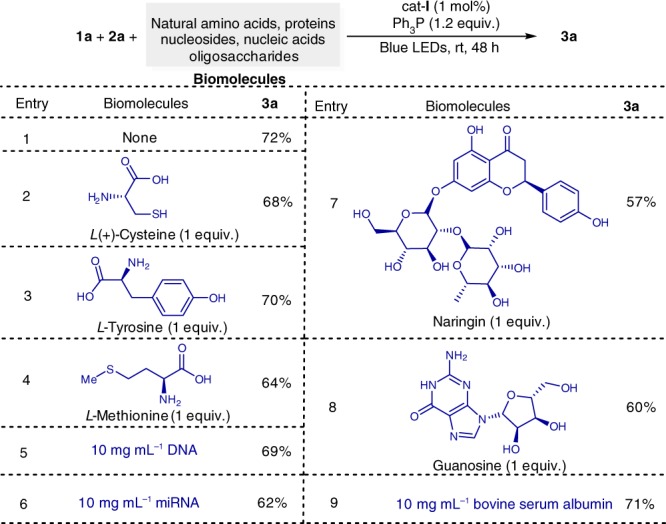
Examining functional group compatibility. Reaction conditions: photocatalyst I (1 mol%), 1a (0.1 mmol, 1.0 equiv.), 2a (0.15 mmol, 1.5 equiv.), Ph3P (0.12 mmol, 1.2 equiv.), biomolecules, pH 7.4 PBS buffer/DCM (1:1, 2.0 mL), blue LEDs, 25 °C
Synthetic application
The late-stage modification of complex molecules is a basis for the evaluation of a practical protocol. In this context, several biologically important natural products, pharmaceuticals, and agrochemicals were successfully used in this reaction and are shown in Fig. 5a. Three pharmaceuticals with an aromatic acid unit, telmisartan (4), hiestrone (5), and adapalene (6) readily underwent this deoxygenative ketone synthesis. Moreover, 11 complex alkene substrates bearing varying functional groups could be employed, affording the desired products (7–17) in moderate yields in aqueous solution. Interestingly, when two competing electron-deficient alkenes were assembled into one molecule, site-specific hydroacylation occurred at the less sterically hindered site (15). These examples clearly suggest that this strategy represents a promising late-stage application of both carboxylic acids and alkenes, and has the potential to rapidly convert two widely available starting materials into complex ketone molecules.
Fig. 5.
Synthetic application. a Late-stage application in the complex molecules. b Synthesis of zolpidem
To underline its synthetic potential, we have applied this deoxygenative coupling protocol to synthesize the drug zolpidem, which ranks 28 in the 200 top-selling drugs (https://njardarson.lab.arizona.edu/sites/njardarson.lab.arizona.edu/files/2016Top200PharmaceuticalPrescriptionSalesPosterLowResV2.pdf). As illustrated in Fig. 5b, six steps are usually required for the synthesis of zolpidem38 from air-sensitive 2-bromo-1-(p-tolyl)ethan-1-one with 19% total yield, but we achieved a concise three-step synthesis of zolpidem with 50% total yield. First, application of deoxygenative C–C coupling of para-methylbenzoic acid (1a) with the electron-deficient alkene (18) successfully produced a γ-carbonyl amide (19) and a subsequent cyclization revealed a simple strategy for the synthesis of zolpidem from commercially abundant para-methylbenzoic acids.
Intramolecular macrocyclization
Macrocyclic ketones are used widely as fragrances, such as muskon and zibeton. To date, the macrocyclization remains a robust but highly challenging synthetic strategy, which usually calls for very low concentrations to avoid intermolecular polymerization39. To further demonstrate the practicality of our method, we adapted the visible-light-mediated direct deoxygenation C–C coupling to an elegant macrocyclization under optimized conditions in aqueous solution. As shown in Fig. 6,18–20 membered cyclophane-braced cycloketones (21a–c) have been successfully constructed in synthetically useful yields, clearly demonstrating the robustness of this synthetic protocol.
Fig. 6.
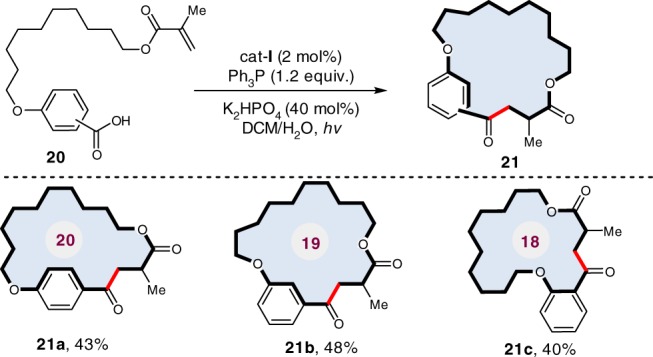
Deoxygenative macrocyclization in the synthesis of cyclophane-braced cycloketones
Downstream transformation
Heterocyclic scaffolds are prevalent motifs in bioactive compounds and natural products40. The ketones produced in this reaction were versatile building blocks for chemical bond formation41,42 and could undergo a broad array of downstream organic transformations to construct structurally diverse nitrogen-containing heterocycles (22, 24, 26, and 28, Fig. 7). Interestingly, with 5 mol% chiral phosphoric acid 27 as catalyst, treatment of 3ii with Hantzsch ester furnished a benzo-fused quinolizidine scaffold (28) with moderate enantioselectivity43.
Fig. 7.
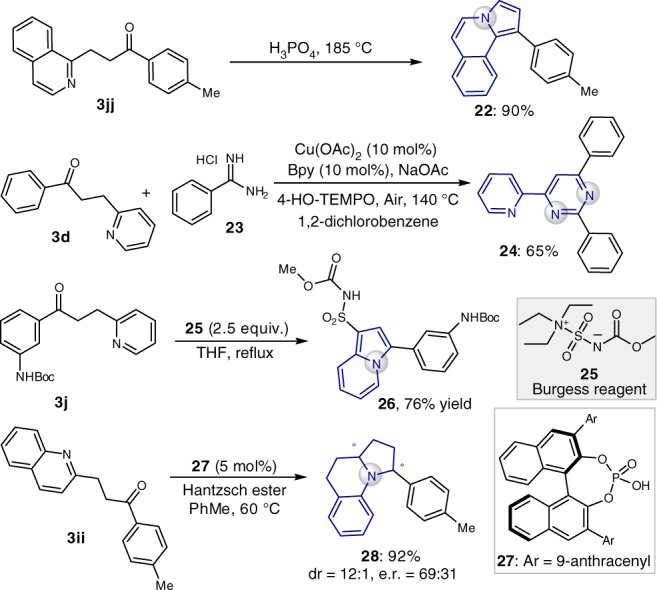
Downstream transformations
Mechanistic studies
To gain mechanistic insight into this deoxygenative C–C coupling, radical inhibitors such as 2,2,6,6-tetramethyl-1-piperidyloxy (TEMPO) and 2,6-di-tert-butyl-p-cresol were added to the model reaction system and it was found that they completely inhibited the coupling reaction. Moreover, the corresponding acyl radical was trapped by TEMPO (Fig. 8a). This indicates that an acyl radical pathway could be possible44–47. The intramolecular hydroacylation of 2-allylbenzoic acid (29) further exemplified the intermediacy of the acyl radical species (Fig. 8b) and the deuterium-labeling experiments demonstrated water was the sole proton source for this deoxygenative hydroacylation of alkenes (Fig. 8c)48. The employment of 18O-labeled water and aromatic acid (1a′) strongly suggested that the oxygen atom of triphenylphosphine oxide would originate from carboxylic acids rather than from water (Fig. 8d). When potassium benzoate was employed in place of benzoic acid, 3d was obtained in moderate yield, which suggests that the triphenylphosphine radical cation reacts with an aromatic carboxylate anion (Fig. 8e). The corresponding Stern–Volmer studies further revealed that photoexcited *[Ir(dF(CF3)ppy)2(dtbbpy)]PF6 was quenched by triphenylphosphine (see Supplementary Information).
Fig. 8.
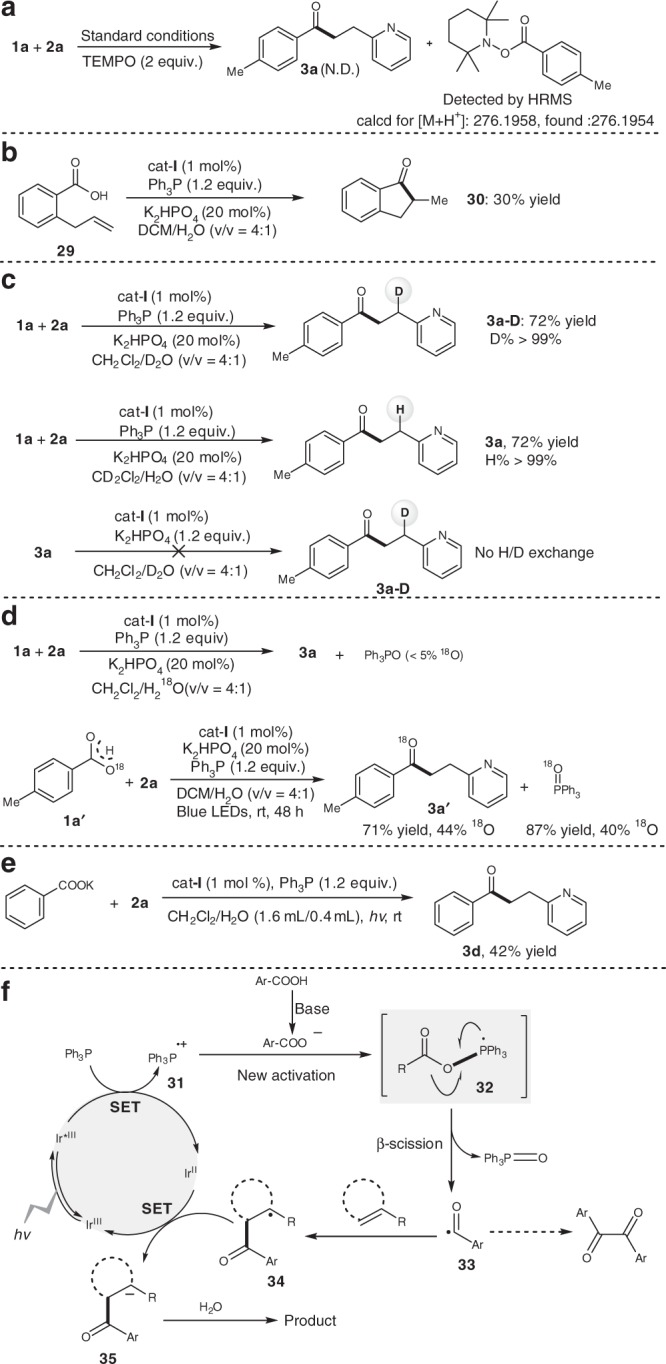
Mechanistic studies. a Control experiments with additives. b Radical cyclization experiment. c Deuterium-labeling experiments. d 18O-labeling experiments. e Aromatic carboxylate anion as substrate. f Proposed mechanism
A possible mechanism is proposed in Fig. 8f. The photoexcited *Ir(dF(CF3)ppy)2(dtbbpy)]PF6 [E1/2red (*IrIII/IrII) = +1.21 V vs SCE; τ = 2.3 μs]49 is able to undergo single-electron transfer (SET) oxidation with Ph3P (E1/2red = +0.98 V vs SCE)50 to form the triphenylphosphine radical cation (31), which could trigger the proposed radical deoxygenation51. The resulting radical cation (31) reacts with carboxylate anion to generate the phosphoryl radical (32). This is followed by β-selective C(acyl)–O bond cleavage with thermodynamic impetus for the formation of Ph3P = O. The acyl radical (33) generated in this way then selectively attacks the alkene to form the radical species (34), which is capable of undergoing an SET with reductive IrII species to afford the corresponding ketone in the presence of water. Alternatively, the homocoupling of acyl radicals (33) can afford a little amount of 1,2-diketones as byproducts.
Three-component reductive coupling
Based on this reductive quenching mechanism, we extended this deoxygenative catalytic system to an attractive three-component reductive coupling reaction of carboxylic acids (1), primary amines (36), and aromatic aldehydes (37). To our delight, the resulting valuable α-amino ketone products (38) were obtained in moderate yields (Fig. 9).
Fig. 9.

A three-component reductive coupling reaction
Discussion
In summary, a deoxygenative ketone synthesis from aromatic carboxylic acids and alkenes has been developed in aqueous solution enabled by visible-light photoredox catalysis with commercially cheap triphenylphosphine as an oxygen transfer reagent. This catalytic system enables direct deoxygenation of aromatic acids to generate acyl radical in the presence of a broad variety of biomolecules. This ketone synthesis strategy allows practical and friendly reaction conditions, which significantly broadens the substrate scope, improves the functional group compatibility, and emphasizes the synthetic application in complex molecules. Based on the direct deoxygenative mechanism, a reductive three-component coupling reaction of amines, aldehydes and acids has been achieved. It offers not only a strategy for the streamlined synthesis of structurally diverse ketones from abundant carboxylic acids, but also a photoredox radical activation mode beyond the redox potential of carboxylic acids.
Methods
General methods
See Supplementary Methods for further details.
General procedure for the synthesis of 3
To a 10 mL Schlenk tube equipped with a magnetic stir bar was added aromatic carboxylic acid 1 (0.2 mmol, 1.0 equiv.), photocatalyst Ir[dF(CF3)ppy]2(dtbbpy)PF6 (2.3 mg, 1 mol%), K2HPO4 (7.0 mg, 20 mol%), and Ph3P (62.9 mg, 0.24 mmol, 1.2 equiv.) and the tube was evacuated and backfilled with argon for three times. The alkenes 2 (0.3 mmol, 1.5 equiv.) in DCM/H2O (2.0 mL, 4:1 v/v) were added by syringe under argon. The tube was then sealed and was placed at a distance (app. 5 cm) from 5 W blue light-emitting diode (LED) lamp, and the mixture was stirred for 36–60 h at room temperature. After completion, the mixture was quenched with water and extracted with DCM (3 × 10 mL). The combined organic layer was dried over anhydrous Na2SO4, then the solvent was removed under vacuo. The residue was subjected to chromatography column on silica gel (eluent: petroleum ether/ethyl acetate) to give the corresponding ketone products 3.
General procedure for the synthesis of 4–8
To a 10 mL Schlenk tube equipped with a magnetic stir bar was added aromatic carboxylic acid 1 (0.1 mmol, 1.0 equiv.), photocatalyst Ir[dF(CF3)ppy]2(dtbbpy)PF6 (2.3 mg, 2 mol%), K2HPO4 (3.5 mg, 20 mol%), and Ph3P (31.5 mg, 0.12 mmol, 1.2 equiv.) and the tube was evacuated and backfilled with argon for three times. The alkenes 2 (0.15 mmol, 1.5 equiv.) in DCM/H2O (2.0 mL, 4:1 v/v) were added by syringe under argon. The tube was then sealed and was placed at a distance (app. 5 cm) from 5 W blue LED lamp, and the mixture was stirred for 48 h at room temperature. After completion, the mixture was quenched with water and extracted with DCM (3 × 10 mL). The combined organic layer was dried over anhydrous Na2SO4, then the solvent was removed under vacuo. The residue was purified with chromatography column on silica gel (eluent: petroleum ether/ethyl acetate) to give the corresponding ketone products 4–8.
General procedure for the synthesis of 9–17
To a 10 mL Schlenk tube equipped with a magnetic stir bar was added aromatic carboxylic acid 1 (0.15 mmol, 1.5 equiv.), photocatalyst Ir[dF(CF3)ppy]2(dtbbpy)PF6 (2.3 mg, 2 mol%), K2HPO4 (7.0 mg, 40 mol%), and Ph3P (31.5 mg, 0.12 mmol, 1.2 equiv.) and the tube was evacuated and backfilled with argon for three times. The alkenes (0.1 mmol, 1.0 equiv.) in DCM/H2O (2.0 mL, 4:1 v/v) were added by syringe under argon. The tube was then sealed and was placed at a distance (app. 5 cm) from 5 W blue LED lamp, and the mixture was stirred for 48 h at room temperature. After completion, the mixture was quenched with water and extracted with DCM (3 × 10 mL). The combined organic layer was dried over anhydrous Na2SO4, then the solvent was removed under vacuo. The residue was purified with chromatography column on silica gel (eluent: petroleum ether/ethyl acetate) to give the corresponding ketone products 9–17.
General procedure for the synthesis of 21
To a 10 mL Schlenk tube equipped with a magnetic stir bar was added aromatic carboxylic acid (36.2 mg, 0.1 mmol, 1.0 equiv.), photocatalyst Ir[dF(CF3)ppy]2(dtbbpy)PF6 (2.3 mg, 2 mol%), K2HPO4 (7.0 mg, 40 mol%), and Ph3P (31.5 mg, 0.12 mmol, 1.2 equiv.) and the tube was evacuated and backfilled with argon for three times. Then, DCM/H2O (2.0 mL, 4:1 v/v) were added by syringe under argon. The tube was then sealed and was placed at a distance (app. 5 cm) from 5 W blue LED lamp, and the mixture was stirred under room temperature for 48 h. After completion, the mixture was quenched with water and extracted with DCM (3 × 10 mL). The combined organic layer was dried over anhydrous Na2SO4, then the solvent was removed under vacuo. The residue was purified with chromatography column on silica gel (eluent: petroleum ether/ethyl acetate) to give the corresponding macrocyclic products 21.
General procedure for the synthesis of 38
To a 10 mL Schlenk tube equipped with a magnetic stir bar was added aromatic carboxylic acid 1 (0.15 mmol, 1.5 equiv.), photocatalyst Ir[dF(CF3)ppy]2(dtbbpy)PF6 (1.2 mg, 1 mol%), K2HPO4 (26.1 mg, 1.5 equiv.), and Ph3P (31.5 mg, 0.12 mmol, 1.2 equiv.) and the tube was evacuated and backfilled with argon for three times. The amines 36 (0.1 mmol, 1.0 equiv.) and aldehydes 37 (0.15 mmol, 1.5 equiv.) in DCM (2.0 mL) were added by syringe under argon. The tube was then sealed and was placed at a distance (app. 5 cm) from 5 W blue LED lamp, and the mixture was stirred at room temperature for 48 h. After completion, the solvent was removed under vacuo. The resulting residue was subjected to chromatography column on silica gel (eluent: petroleum ether/ethyl acetate) to give the corresponding α-amino ketone products 38.
Electronic supplementary material
Acknowledgements
We gratefully acknowledge the National Natural Science Foundation of China (21702098, 21672099, and 21732003), “1000 Youth Talents Plan”, and the Fundamental Research Funds for the Central Universities (No. 020514380158 and 020514380131). M.Z. was supported by Nanjing University Innovation and Creative Program for Ph.D. candidate (No. CXCY17-19). Prof. Carl Johan Wallentin at Gothenburg University (Sweden) is kindly acknowledged for his helpful paper discussion.
Author contributions
M.Z. performed and analyzed the experiments. M.Z., J.X. and C.Z. co-wrote and discussed the manuscript. J.X. conceived and directed the whole project. All authors commented on the final manuscript and contributed to the analysis and interpretation of the results.
Data availability
The authors declare that all other data supporting the findings of this study are available within the article and Supplementary Information files, and also are available from the corresponding author upon reasonable request.
Competing interests
The authors declare no competing interests.
Footnotes
Publisher's note: Springer Nature remains neutral with regard to jurisdictional claims in published maps and institutional affiliations.
Contributor Information
Jin Xie, Email: xie@nju.edu.cn.
Chengjian Zhu, Email: cjzhu@nju.edu.cn.
Electronic supplementary material
Supplementary Information accompanies this paper at 10.1038/s41467-018-06019-1.
References
- 1.Gooßen LJ, Deng G, Levy LM. Synthesis of biaryls via catalytic decarboxylative coupling. Science. 2006;313:662–664. doi: 10.1126/science.1128684. [DOI] [PubMed] [Google Scholar]
- 2.Gooßen Lukas J, et al. New catalytic transformations of carboxylic acids. Pure Appl. Chem. 2008;80:1725–1733. doi: 10.1351/pac200880081725. [DOI] [Google Scholar]
- 3.Rodriguez N, Goossen LJ. Decarboxylative coupling reactions: a modern strategy for C-C-bond formation. Chem. Soc. Rev. 2011;40:5030–5048. doi: 10.1039/c1cs15093f. [DOI] [PubMed] [Google Scholar]
- 4.Wei Y, Hu P, Zhang M, Su W. Metal-catalyzed decarboxylative C–H functionalization. Chem. Rev. 2017;117:8864–8907. doi: 10.1021/acs.chemrev.6b00516. [DOI] [PubMed] [Google Scholar]
- 5.Pedley, J. B. Thermochemical Data and Structure of Organic Compounds, (Texas A & M Univ., Texas, 1994).
- 6.Denisov ET, Denisova TG. Kinetics and thermodynamics of formation and degradation of α-hydroxyperoxyl radicals. Pet. Chem. 2006;46:373–383. doi: 10.1134/S0965544106060016. [DOI] [Google Scholar]
- 7.Brunet JJ, Chauvin R. Synthesis of diarylketones through carbonylative coupling. Chem. Soc. Rev. 1995;24:89–95. doi: 10.1039/cs9952400089. [DOI] [Google Scholar]
- 8.Olah, G. A. Friedel-Craſts Chemistry (Wiley-Interscience, New York, 1973).
- 9.Nahm S, Weinreb SM. N-methoxy-N-methylamides as effective acylating agents. Tetrahedron Lett. 1981;22:3815–3818. doi: 10.1016/S0040-4039(01)91316-4. [DOI] [Google Scholar]
- 10.Shen ZL, et al. Synthesis of water-tolerant indium homoenolate in aqueous media and its application in the synthesis of 1,4-dicarbonyl compounds via palladium-catalyzed coupling with acid chloride. J. Am. Chem. Soc. 2010;132:15852–15855. doi: 10.1021/ja106925f. [DOI] [PubMed] [Google Scholar]
- 11.Wu F, Lu W, Qian Q, Ren Q, Gong H. Ketone formation via mild nickel-catalyzed reductive coupling of alkyl halides with aryl acid chlorides. Org. Lett. 2012;14:3044–3047. doi: 10.1021/ol3011198. [DOI] [PubMed] [Google Scholar]
- 12.Arockiam PB, Bruneau C, Dixneuf PH. Ruthenium(II)-catalyzed C–H bond activation and functionalization. Chem. Rev. 2012;112:5879–5918. doi: 10.1021/cr300153j. [DOI] [PubMed] [Google Scholar]
- 13.Hie L, et al. Nickel-catalyzed activation of acyl C−O Bonds of methyl esters. Angew. Chem. Int. Ed. 2016;55:2810–2814. doi: 10.1002/anie.201511486. [DOI] [PMC free article] [PubMed] [Google Scholar]
- 14.Ben Halima T, et al. Palladium-catalyzed Suzuki–Miyaura coupling of aryl Esters. J. Am. Chem. Soc. 2017;139:1311–1318. doi: 10.1021/jacs.6b12329. [DOI] [PubMed] [Google Scholar]
- 15.Sun F, et al. Cleavage of the C(O)–S bond of thioesters by palladium/norbornene/copper cooperative catalysis: an efficient synthesis of 2-(Arylthio)aryl ketones. J. Am. Chem. Soc. 2016;138:7456–7459. doi: 10.1021/jacs.6b02495. [DOI] [PubMed] [Google Scholar]
- 16.Bechara WS, Pelletier G, Charette AB. Chemoselective synthesis of ketones and ketimines by addition of organometallic reagents to secondary amides. Nat. Chem. 2012;4:228. doi: 10.1038/nchem.1268. [DOI] [PubMed] [Google Scholar]
- 17.Hie L, et al. Conversion of amides to esters by the nickel-catalysed activation of amide C-N bonds. Nature. 2015;524:79–83. doi: 10.1038/nature14615. [DOI] [PMC free article] [PubMed] [Google Scholar]
- 18.Walker JA, Vickerman KL, Humke JN, Stanley LM. Ni-catalyzed alkene carboacylation via amide C–N bond activation. J. Am. Chem. Soc. 2017;139:10228–10231. doi: 10.1021/jacs.7b06191. [DOI] [PubMed] [Google Scholar]
- 19.Takise R, Muto K, Yamaguchi J. Cross-coupling of aromatic esters and amides. Chem. Soc. Rev. 2017;46:5864–5888. doi: 10.1039/C7CS00182G. [DOI] [PubMed] [Google Scholar]
- 20.Guo L, Rueping M. Decarbonylative cross-couplings: nickel catalyzed functional group interconversion strategies for the construction of complex organic molecules. Acc. Chem. Res. 2018;51:1185–1195. doi: 10.1021/acs.accounts.8b00023. [DOI] [PubMed] [Google Scholar]
- 21.Bergonzini G, Cassani C, Wallentin CJ. Acyl radicals from aromatic carboxylic acids by means of visible-light photoredox catalysis. Angew. Chem. Int. Ed. 2015;54:14066–14069. doi: 10.1002/anie.201506432. [DOI] [PMC free article] [PubMed] [Google Scholar]
- 22.Dong Z, Wang J, Ren Z, Dong G. Ortho C-H acylation of aryl iodides by palladium/norbornene catalysis. Angew. Chem. Int. Ed. 2015;54:12664–12668. doi: 10.1002/anie.201506397. [DOI] [PubMed] [Google Scholar]
- 23.Zhang M, et al. Photoredox-catalyzed hydroacylation of olefins employing carboxylic acids and hydrosilanes. Org. Lett. 2017;19:3430–3433. doi: 10.1021/acs.orglett.7b01391. [DOI] [PubMed] [Google Scholar]
- 24.Maryanoff BE, Reitz AB. The Wittig olefination reaction and modifications involving phosphoryl-stabilized carbanions. Stereochemistry, mechanism, and selected synthetic aspects. Chem. Rev. 1989;89:863–927. doi: 10.1021/cr00094a007. [DOI] [Google Scholar]
- 25.Zhou N, Yuan XA, Zhao Y, Xie J, Zhu C. Synergistic photoredox catalysis and organocatalysis for inverse hydroboration of imines. Angew. Chem. Int. Ed. 2018;57:3990–3994. doi: 10.1002/anie.201800421. [DOI] [PubMed] [Google Scholar]
- 26.Li W, Xu W, Xie J, Yu S, Zhu C. Distal radical migration strategy: an emerging synthetic means. Chem. Soc. Rev. 2018;47:654–667. doi: 10.1039/C7CS00507E. [DOI] [PubMed] [Google Scholar]
- 27.Xu P, Li W, Xie J, Zhu C. Exploration of C–H transformations of aldehyde hydrazones: radical strategies and beyond. Acc. Chem. Res. 2018;51:484–495. doi: 10.1021/acs.accounts.7b00565. [DOI] [PubMed] [Google Scholar]
- 28.Xu P, et al. Visible-light photoredox-catalyzed C-H difluoroalkylation of hydrazones through an aminyl radical/polar mechanism. Angew. Chem. Int. Ed. 2016;55:2939–2943. doi: 10.1002/anie.201508698. [DOI] [PubMed] [Google Scholar]
- 29.Guan AY, Liu CL, Sun XF, Xie Y, Wang MA. Discovery of pyridine-based agrochemicals by using intermediate derivatization methods. Bioorg. Med. Chem. 2016;24:342–353. doi: 10.1016/j.bmc.2015.09.031. [DOI] [PubMed] [Google Scholar]
- 30.Chelucci G. Metal-complexes of optically active amino- and imino-based pyridine ligands in asymmetric catalysis. Coord. Chem. Rev. 2013;257:1887–1932. doi: 10.1016/j.ccr.2012.12.002. [DOI] [Google Scholar]
- 31.Vasilopoulos A, Zultanski SL, Stahl SS. Feedstocks to pharmacophores: Cu-catalyzed oxidative arylation of inexpensive alkylarenes enabling direct access to diarylalkanes. J. Am. Chem. Soc. 2017;139:7705–7708. doi: 10.1021/jacs.7b03387. [DOI] [PubMed] [Google Scholar]
- 32.Xie J, Huang ZZ. The cascade carbo-carbonylation of unactivated alkenes catalyzed by an organocatalyst and a transition metal catalyst: a facile approach to γ-diketones and γ-carbonyl aldehydes from arylalkenes under air. Chem. Commun. 2010;46:1947–1949. doi: 10.1039/b921310d. [DOI] [PubMed] [Google Scholar]
- 33.Hashmi ASK, Wang T, Shi S, Rudolph M. Regioselectivity switch: gold(I)-catalyzed oxidative rearrangement of propargyl alcohols to 1,3-diketones. J. Org. Chem. 2012;77:7761–7767. doi: 10.1021/jo301381z. [DOI] [PubMed] [Google Scholar]
- 34.Balasubramaniam S, Aiden IS. The growing synthetic utility of the Weinreb amide. Synthesis. 2008;2008:3707–3738. doi: 10.1055/s-0028-1083226. [DOI] [Google Scholar]
- 35.Collins KD, Glorius F. A robustness screen for the rapid assessment of chemical reactions. Nat. Chem. 2013;5:597. doi: 10.1038/nchem.1669. [DOI] [PubMed] [Google Scholar]
- 36.Huang H, Zhang G, Gong L, Zhang S, Chen Y. Visible-light-induced chemoselective deboronative alkynylation under biomolecule-compatible conditions. J. Am. Chem. Soc. 2014;136:2280–2283. doi: 10.1021/ja413208y. [DOI] [PubMed] [Google Scholar]
- 37.Xuan J, Zhang ZG, Xiao WJ. Visible-light-induced decarboxylative functionalization of carboxylic acids and their derivatives. Angew. Chem. Int. Ed. 2015;54:15632–15641. doi: 10.1002/anie.201505731. [DOI] [PubMed] [Google Scholar]
- 38.Jasty, A. M. et al. Process for preparing zolpidem. USP 20070027180A1 (2007).
- 39.Martí-Centelles V, Pandey MD, Burguete MI, Luis SV. Macrocyclization reactions: the importance of conformational, configurational, and template-induced preorganization. Chem. Rev. 2015;115:8736–8834. doi: 10.1021/acs.chemrev.5b00056. [DOI] [PubMed] [Google Scholar]
- 40.Wamhoff, H. Comprehensive Heterocyclic Chemistry (Academic Press, New York, 1984).
- 41.Chudasama V, Fitzmaurice RJ, Caddick S. Hydroacylation of α,β-unsaturated esters via aerobic C–H activation. Nat. Chem. 2010;2:592. doi: 10.1038/nchem.685. [DOI] [PubMed] [Google Scholar]
- 42.Wang H, Dai XJ, Li CJ. Aldehydes as alkyl carbanion equivalents for additions to carbonyl compounds. Nat. Chem. 2016;9:374. doi: 10.1038/nchem.2677. [DOI] [PubMed] [Google Scholar]
- 43.Rueping M, Hubener L. Enantioselective synthesis of quinolizidines and indolizidines via a catalytic asymmetric hydrogenation cascade. Synlett. 2011;2011:1243–1246. doi: 10.1055/s-0030-1259955. [DOI] [Google Scholar]
- 44.Liu J, et al. Visible-light-mediated decarboxylation/oxidative amidation of α-keto acids with amines under mild reaction conditions using O2. Angew. Chem. Int. Ed. 2014;53:502–506. doi: 10.1002/anie.201308614. [DOI] [PubMed] [Google Scholar]
- 45.Mukherjee S, Garza-Sanchez RA, Tlahuext-Aca A, Glorius F. Alkynylation of C (O)–H bonds enabled by photoredox‐mediated hydrogen‐atom transfer. Angew. Chem. Int. Ed. 2017;56:14723–14726. doi: 10.1002/anie.201708037. [DOI] [PubMed] [Google Scholar]
- 46.Jia K, Pan Y, Chen Y. Selective carbonyl−C(sp3) bond cleavage to construct ynamides, ynoates, and ynones by photoredox catalysis. Angew. Chem. Int. Ed. 2017;56:2478–2481. doi: 10.1002/anie.201611897. [DOI] [PubMed] [Google Scholar]
- 47.Zhang X, MacMillan DWC. Direct aldehyde C-H arylation and alkylation via the combination of nickel, hydrogen atom transfer, and photoredox catalysis. J. Am. Chem. Soc. 2017;139:11353–11356. doi: 10.1021/jacs.7b07078. [DOI] [PMC free article] [PubMed] [Google Scholar]
- 48.Spiegel DA, Wiberg KB, Schacherer LN, Medeiros MR, Wood JL. Deoxygenation of alcohols employing water as the hydrogen atom source. J. Am. Chem. Soc. 2005;127:12513–12515. doi: 10.1021/ja052185l. [DOI] [PubMed] [Google Scholar]
- 49.Prier CK, Rankic DA, MacMillan DWC. Visible light photoredox catalysis with transition metal complexes: applications in organic synthesis. Chem. Rev. 2013;113:5322–5363. doi: 10.1021/cr300503r. [DOI] [PMC free article] [PubMed] [Google Scholar]
- 50.Pandey G, Pooranchand D, Bhalerao UT. Photoinduced single electron transfer activation of organophosphines: Nucleophilic trapping of phosphine radical cation. Tetrahedron. 1991;47:1745–1752. doi: 10.1016/S0040-4020(01)96916-9. [DOI] [Google Scholar]
- 51.Schiavon G, Zecchin S, Cogoni G, Bontempelli G. Anodic oxidation of triphenylphosphine at a platinum electrode in acetonitrile medium. J. Electroanal. Chem. Interfac. 1973;48:425–431. doi: 10.1016/S0022-0728(73)80375-4. [DOI] [Google Scholar]
Associated Data
This section collects any data citations, data availability statements, or supplementary materials included in this article.
Supplementary Materials
Data Availability Statement
The authors declare that all other data supporting the findings of this study are available within the article and Supplementary Information files, and also are available from the corresponding author upon reasonable request.




